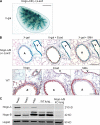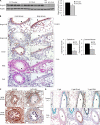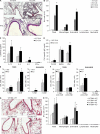Epithelial reticulon 4B (Nogo-B) is an endogenous regulator of Th2-driven lung inflammation
- PMID: 20975041
- PMCID: PMC2989775
- DOI: 10.1084/jem.20100786
Epithelial reticulon 4B (Nogo-B) is an endogenous regulator of Th2-driven lung inflammation
Abstract
Nogo-B is a member of the reticulon family of proteins (RTN-4B) that is highly expressed in lung tissue; however, its function remains unknown. We show that mice with Th2-driven lung inflammation results in a loss of Nogo expression in airway epithelium and smooth muscle compared with nonallergic mice, a finding which is replicated in severe human asthma. Mice lacking Nogo-A/B (Nogo-KO) display an exaggerated asthma-like phenotype, and epithelial reconstitution of Nogo-B in transgenic mice blunts Th2-mediated lung inflammation. Microarray analysis of lungs from Nogo-KO mice reveals a marked reduction in palate lung and nasal clone (PLUNC) gene expression, and the levels of PLUNC are enhanced in epithelial Nogo-B transgenic mice. Finally, transgenic expression of PLUNC into Nogo-KO mice rescues the enhanced asthmatic-like responsiveness in these KO mice. These data identify Nogo-B as a novel protective gene expressed in lung epithelia, and its expression regulates the levels of the antibacterial antiinflammatory protein PLUNC.
Figures






Similar articles
-
Endothelial reticulon-4B (Nogo-B) regulates ICAM-1-mediated leukocyte transmigration and acute inflammation.Blood. 2011 Feb 17;117(7):2284-95. doi: 10.1182/blood-2010-04-281956. Epub 2010 Dec 23. Blood. 2011. PMID: 21183689 Free PMC article.
-
A new role for reticulon-4B/NOGO-B in the intestinal epithelial barrier function and inflammatory bowel disease.Am J Physiol Gastrointest Liver Physiol. 2015 Jun 15;308(12):G981-93. doi: 10.1152/ajpgi.00309.2014. Epub 2015 Apr 23. Am J Physiol Gastrointest Liver Physiol. 2015. PMID: 25907690
-
Reticulon 4B (Nogo-B) is a novel regulator of hepatic fibrosis.Hepatology. 2011 Apr;53(4):1306-15. doi: 10.1002/hep.24200. Hepatology. 2011. PMID: 21480333 Free PMC article.
-
[Biological function of Nogo-B].Sheng Li Xue Bao. 2013 Aug 25;65(4):445-50. Sheng Li Xue Bao. 2013. PMID: 23963076 Review. Chinese.
-
Comparative analysis of the PLUNC (palate, lung and nasal epithelium clone) protein families.Biochem Soc Trans. 2003 Aug;31(Pt 4):806-9. doi: 10.1042/bst0310806. Biochem Soc Trans. 2003. PMID: 12887310 Review.
Cited by
-
Is there a regulatory role of immunoglobulins on tissue forming cells relevant in chronic inflammatory lung diseases?J Allergy (Cairo). 2011;2011:721517. doi: 10.1155/2011/721517. Epub 2011 Nov 2. J Allergy (Cairo). 2011. PMID: 22121383 Free PMC article.
-
Ras transformation results in cleavage of reticulon protein Nogo-B that is associated with impairment of IFN response.Cell Cycle. 2015;14(14):2301-10. doi: 10.1080/15384101.2015.1044187. Epub 2015 May 6. Cell Cycle. 2015. PMID: 25946643 Free PMC article.
-
Nogo-B regulates migration and contraction of airway smooth muscle cells by decreasing ARPC 2/3 and increasing MYL-9 expression.Respir Res. 2011 Jan 21;12(1):14. doi: 10.1186/1465-9921-12-14. Respir Res. 2011. PMID: 21251247 Free PMC article.
-
Transplantation of HUVECs with genetically modified Nogo-B accelerates wound-healing in nude mice.Am J Transl Res. 2019 May 15;11(5):2866-2876. eCollection 2019. Am J Transl Res. 2019. PMID: 31217860 Free PMC article.
-
The role of Nogo and the mitochondria-endoplasmic reticulum unit in pulmonary hypertension.Sci Transl Med. 2011 Jun 22;3(88):88ra55. doi: 10.1126/scitranslmed.3002194. Sci Transl Med. 2011. PMID: 21697531 Free PMC article.
References
-
- Chu H.W., Thaikoottathil J., Rino J.G., Zhang G., Wu Q., Moss T., Refaeli Y., Bowler R., Wenzel S.E., Chen Z., et al. 2007. Function and regulation of SPLUNC1 protein in Mycoplasma infection and allergic inflammation. J. Immunol. 179:3995–4002 - PubMed
Publication types
MeSH terms
Substances
Grants and funding
LinkOut - more resources
Full Text Sources
Other Literature Sources
Medical
Molecular Biology Databases
Research Materials

